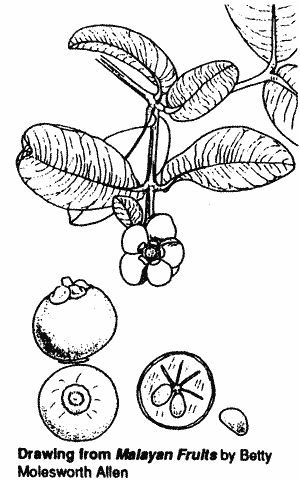
THE MANGOSTEEN ALTERNATIVE
SCIENTIFIC NAME: Garcinia prainiana
FAMILY: Guttiferae
Growing the 'button mangosteen' (Garcinia prainiana) is an attractive alternative to growing its namesake, the true mangosteen (G. mangostana). Some of the writer's button mangosteen plants have flowered in their pots when only two feet high. This suggests the possibility of this Thai/Malaysian tree fruiting years before a seedling mangosteen even flowers. Both the button mangosteen and the mangosteen are intolerant of low temperatures. However, when it gets cold, it is far easier to bring a 3-gallon potted button mangosteen inside than to cover up and protect a bearing size, 12 ft. to 15 ft. mangosteen growing outside.
Growing the button mangosteen in containers is a wonderful opportunity for the adventurous indoor or patio gardener.
The button mangosteen, also known as cherapu, is a small to mid-size tree indigenous to the Asiatic tropics, where it occurs in Thailand and Malaysia. Seeds of this Garcinia were received by the writer in 1980.
Three of the resulting seedlings, upon reaching a height of one metre, were planted out in the writer's Bal Harbour grove, just north of Miami Beach.

It was soon discovered that this mangosteen relative required partial shade in its juvenile stage. To eliminate the adverse affects of full sunlight, an overhead 63% shade cloth top was erected, the sides remaining open. In 1988, the first fruit appeared, although some of the plants in three-gallon containers had flowered a few years earlier. At about the same time, Adolf Grimal, on Big Pine Key 20 miles north of Key West, reported one of his trees from the same seed batch to be in fruit.
The button mangosteen has similar foliage to the mangosteen, with attractive dark green, shiny leaves about 8 inches long by 4 inches wide, the undersides pale green with prominent veins. The base of each leaf appears to wrap around the branch, as if it had no petiole. Young twigs and branches are dark green turning to a brownish gray with increasing size and maturity. The trees are dioecious, requiring both a male and a female to bear. The beautiful rose-colored, camellia-like flowers of both sexes are about 1½ inches wide. Because both appear so much alike, it takes a close inspection to see which has the pollen and is the male. The bloom, which appears singly or in tight clusters, gives this Asiatic tree a highly ornamental appearance.
The attractive bright-orange fruit, standing out in sharp contrast to the deep-green foliage, appear from mid-summer into fall. Hand-pollinating was found to be followed nearly always by successful fruit set. The name 'button mangosteen' would seem to originate from the fruit's flattened, button-like appearance, and of course, its similarity to its famous relative. The soft, orange-colored flesh contains two or more seeds. In describing this Asian delicacy, Betty Molesworth Allen, in her book Malayan Fruits, wrote "The fruits are delicious, with an unusual flavor as well as being excellent thirst quenchers". This writer found the button mangosteen's fruit to be sweet with a tinge of tartness that should appeal to most people's palate.
DATE: March 1992
* * * * * * * * * * * * *
